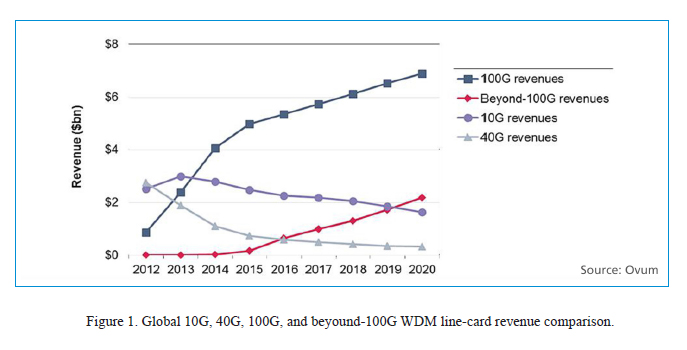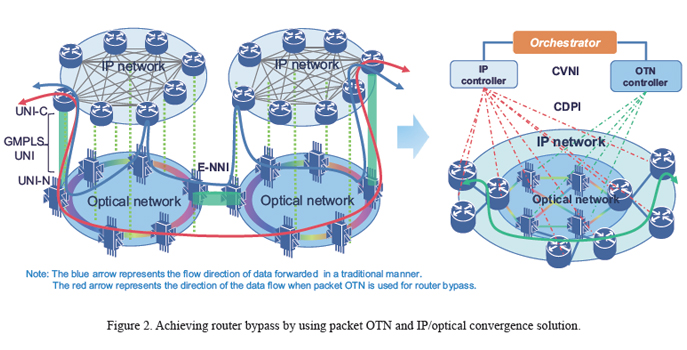Building an Elastic Optical Transport Network
At present, China is going all out to build an information society. While such concepts as 4K HD video, pre-5G and 5G are being proposed and developed, there will be unprecedented demands for network bandwidth. China has issued the "Broadband China" strategy to increase broadband speed and coverage. The rapid increase in access bandwidth requires that the optical transport network (OTN) bear more data traffic. Therefore, the "Broadband China" strategy needs to take OTN as the basic supporting infrastructure.
OTN has entered the beyond-100G era. According to Ovum's "Optical Networks Forecast Report: 2015-20", beyond-100G optical networks will have accelerated commercialization (Fig. 1). Core nodes in the OTN network need to have larger cross-connect capacity to groom big data flow.

In terms of networking, great emphasis should be put on OTN in the metro area, and it is imperative to build an end-to-end OTN system from the metro access/aggregation layer to core layer in order to accommodate increased bandwidth usage. Meanwhile, it should be noted that most service access ports at the access/aggregation layer are GE/10GE, but service ports at the core layer are usually 100GE. Therefore, "service convergence" and "port aggregation" are required during service uplink transmission. In the traditional solution, the OTN is used to build the uplink pipe, the data equipment completes service convergence and port aggregation, and the MSTP equipment carries the TDM private line services. This increases network level and complexity. The packet OTN equipment can not only build large-capacity transport pipes, but also implement service convergence and port aggregation with its packet switching capability, reducing the network level and Capex.
Major Application Scenarios of Packet OTN
The major application scenarios of packet OTN include optimizing optical line terminal (OLT) uplink for family broadband, VIP private line services, and serving as the basis of the converged IP and optical transport layers.
Changing the OLT Uplink for Family Broadband
In the early days, family broadband was mainly available in urban areas since access bandwidth demands were not high and the number of users was not large enough. Most early solutions of OLT uplinking to broadband remote access server (BRAS) used direct fiber connections, resulting in a serious waste of fiber resources.
With the continuous increase of access bandwidth and user number, the OLT uplink bandwidth should be further increased, which challenges the traditional direct fiber connections. Moreover, since China is increasing broadband coverage in rural areas, OLT will expand to other areas. In some counties, the increased transmission distance from OLT to BRAS also challenges the direct fiber connections. Thus, small OTN equipment is deployed to build the uplink pipe from OLT to BRAS, which solves the problems of bandwidth and LH transport and also drives the development of family broadband.
Packet OTN further optimizes the OLT uplink. The traditional solution cannot complete service convergence and port aggregation. Since the OLT uplink port rate is generally lower than the BRAS port rate, aggregation switches need to be deployed to complete service convergence and port aggregation. If the packet OTN is used to create the uplink pipe from OLT to BRAS, it can realize large-capacity LH transmission and also implement service convergence and port aggregation without using aggregation switches. The solution simplifies network layer and helps operators reduce the total network investment by about 30%.
Unified Bearing of Multi-level VIP Private Line Services
VIP private lines have become a major profit growth point for many operators. While the scale and number of enterprises are increasing, the global VIP private line services will have large granularity and become IP-based. In the next few years, the proportion of Ethernet private lines will rise gradually. The private line bandwidth ranging from 2 Mbps to over 10 Mbps will move towards 100–1000 Mbps, and the proportion of large-granularity private line services will rise gradually. However, it should be noted that small-granularity TDM private lines still have a considerable amount of stock in the next 3–5 years, and the co-existence of different private line services will characterize the future VIP private line market.
Therefore, the best VIP private line solution is to bear different private line services while ensuring QoS, and the private line services can be differentiated based on customer type and requirements. The current VIP private line service bearing solution employs a variety of devices. Take China Telecom for example. It is leading in the development of VIP private line services in China. It uses the MSTP network to bear small granularity, low-latency and high reliability VIP private line services, IPRAN to bear small-granularity packet private line services, and OTN to bear private line services for large ICP enterprises. Meanwhile, since MSTP equipment is being phased out, many TDM private line services are in urgent need of a new platform. IPRAN/PTN cannot provide rigid pipes to meet the low latency and high reliability requirements of special enterprises (e.g., finance and electricity). The traditional OTN equipment has rigid pipes but has low bearing efficiency and little flexibility for small-granularity private line services.
The packet OTN equipment changes how VIP private line services are transported. It combines the functions of the traditional OTN, MSTP, PTN, switches and other devices. It provides the advantages of the traditional OTN, such as rigid pipes, low latency and large capacity, and supports scheduling of TDM private line services at VC4 or VC12 level. It is able to bear small-granularity packet private line services and perform statistical multiplexing by using L2 switching or MPLS-TP technology, improving the bearing efficiency and flexibility for small-granularity private line services. Operators only need to build a packet OTN network to meet the bearing requirements of all private lines, reducing network complexity and facilitating operation and maintenance.
IP + Optical Convergence
In recent years, SDN/NFV technology has become the major trend of network development. An important application scenario of SDN technology in the bearer network is IP and optical convergence.
In the existing networks, the IP data layer as represented by core routers and the transport layer as represented by the OTN are independent from each other. The devices in these two layers run independently from each other, and most devices come from different vendors. There is no unified management of the IP and OTN devices and the service creation and provisioning period is long, making operators less competitive. SDN provides a way to create the synergy between the IP and optical layers. It uniformly manages IP and OTN devices through an orchestration mechanism, fulfilling functions such as rapid service provisioning and router bypass.
Implementing SDN needs to be supported by new technologies. The OTN layer needs to be aware of the changes at the IP layer. In many scenarios, the OTN layer should realize some functions performed at the IP layer. Compared with forwarding on core routers, the OTN equipment has advantages in terms of cost, power consumption and latency.
In the traditional IP networks, a large amount of data is forwarded between core routers. The transport layer built by the traditional OTN equipment does not provide packet functions, but only large-capacity pipes. A large amount of data is forwarded on hop-by-hop basis by core routers so that a large amount of resources of core routers are occupied and Opex is increased for operators.
To achieve IP + optical synergy, the packet OTN is used to build the optical channels between the routers. SDN realizes unified control of both the IP and OTN layers. The packet OTN, by using MPLS-TP or L2 VPN technology, creates a bypass channel at the optical layer according to the flow direction of the forwarded data. A large amount of data is forwarded via the bypass channel. There is no hop-by-hop forwarding on the core routers, thus bypassing the core routers (Fig. 2). This solution saves a lot of ports on the core routers and reduces the pressure on the core routers, minimizing operators' operation and maintenance pressure.

Two Ways for Implementing Packet OTN
Packet OTN is mainly divided into two types: board-level packet OTN and centralized packet OTN.
The board-level packet OTN integrates packet processing and OTN functions into one board. Since it does not require a separate cross-connect board, it is suitable for small OTN equipment and is mainly applied to access layer. However, its service processing capability is limited by board port and bandwidth, and it does not support packet switching between the boards.
The centralized packet OTN with centralized cross-connect boards has more powerful functions than the board-level packet OTN. The mainstream centralized packet OTN adopts the universal cell switching technology. The OTN over packet fabric (OPF) protocol, defined by the OIF organization, specifies how to use universal cell switching to transport optical channel data unit-k (ODUk) so as to achieve backplane cross connections. In this method, the device's cross-connect board is taken as a universal cell switching matrix. A variety of services such as ODUk/PKT/VC are sliced into cells on the service boards. These cells then enter the universal cell switching matrix and are switched to the line-side boards where they are encapsulated into an OTUk for further transmission.
ZXONE 9700 is ZTE's new-generation ultra large-capacity packet OTN equipment. It adopts universal cell switching and supports the electrical cross-connect capacity of up to 28.8T. It also supports unified bearing of ODUk, PKT and VC services and non-blocked scheduling of ODUk, TDM and packet services, which can help operators build elastic OTNs.